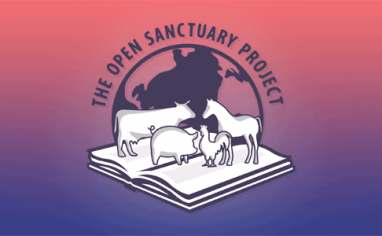
Subscribe To The Open Sanctuary Podcast
If you’d like to get the latest episodes of The Open Sanctuary Podcast, you can subscribe for free on all Podcast platforms, including Apple Podcasts and Spotify!
Episode Notes
At The Open Sanctuary Project, we strongly advocate that you provide appropriate veterinary care for each and every one of your animal residents. This can be tricky at times when it comes to “less traditional” animal companions, like many farmed animalA species or specific breed of animal that is raised by humans for the use of their bodies or what comes from their bodies. species, among others. Establishing a good relationship with your veterinarian is a critical part of ensuring your residents get the care they need! In this episode, our Research Specialist Amber chats with Senior Advisor Tara and NonprofitA non-governmental organization whose primary purpose is something other than selling goods or services. Specialist Julia about some of the ways your sanctuary or rescue can forge a strong relationship and good understanding with your veterinarians!
—
This Episode’s Referenced Open Sanctuary Project Resources:
- Building And Maintaining A Good Relationship Between Your Sanctuary And Veterinarians
- Conflict Support For Your Animal Organization Part 1: Understanding Dominant Culture, How It Shapes Our Behaviors And Envisioning Alternatives
- Conflict Support For Your Animal Organization: Part 2 Building Transformative Relationships: Tools for Challenging Dominant Culture in Everyday Interactions
Episode Transcript (Auto-GeneratedThe following content was transcribed through an automated process and may contain transcription errors or misspellings.)
Amber Barnes: I’m Amber Barnes, the research specialist with the Open Sanctuary Project, and I’m here with my amazing teammates. So, we have Tara, who’s our senior advisor, and Julia, who’s our nonprofit specialist. And today, we’re going to talk a little bit about building and maintaining good relationships with veterinarians, which I think we can all agree, good veterinary care is a vital part of making sure our residents are happy and healthy. And we were just talking about how we could go on about this forever. Pick all day all kinds of tangents here. So, I went ahead and wrote down a few things. So, just to start off, there’s a few points that we’re going to want to make today. We’re just kind of having a conversation, but we realized that it was hard to do that and keep track of where we are. So, I’m first going to talk really quick about reaching out before there’s an emergency. Now, sometimes there’s going to be an emergency and you can’t control that. Or it’s an emergency vet, right? But it’s really great if you start a sanctuary, move it to an area, and you reach out as soon as you can. Start with that. Start before the feelings are really intense and you’re really worried about someone and it’s harder to regulate your emotions. Does anyone want to say anything on that?
Julia Magnus: So, I think if you can reach out before there’s an emergency, in addition to not being all amped up emotionally and having it be a stressful situation where you’re maybe less able to show your best self. If you can reach out before there’s an emergency, you’re showing your veterinarian a few things. One, you’re showing them that you value their services outside of an emergency and that you see their value in terms of providing general non-emergency care and being a collaborative partner in the care of your sanctuary residents. The other thing is if your, I feel like this is sort of related, but if your veterinarian is one that has a clinic that you bring individuals to, only bringing them cases during an emergency is only showing them your sickest animals and is giving them just a sliver of just a limited view of the state your residents are in. It might give them some misconceptions about the care that your residents receive. So, those wellness exams where you’re bringing in healthy individuals or having your vet come out to the sanctuary to see individuals who are in dire need can show them the exceptional care that you hopefully provide to your residents as opposed to them just feeling like, oh my gosh, the sanctuary just has so many sick individuals. What are they doing over there? They can get a more complete picture of your sanctuary and your residents and the care that you provide individuals. I would also want to add that your relationship with your vet starts from the very first phone call that you make when you talk to reception when you schedule your appointment. So, it’s important to recognize that your vet is not just the one doctor that you’re seeing, it’s the entire staff. It’s the whole clinic. These folks are humans and they deal with a lot of stressed out, amped up people with emergency situations. So, if you can maintain professional courtesy and kindness to veterinary staff, that goes a very, very long way from the very first phone call that you make to your veterinarian. Ask how the receptionist is doing today. And when you’re greeted by a technician, ask them how they’re doing and say hello. And remember their names and be kind and courteous to them because they are a critical part of your veterinarian’s team and if you’re not kind to them then that doesn’t reflect well and you can be certain that your vet will hear about that. So from the moment you make the call to the moment you walk in the door it’s always good to just maintain a basic modicum of professional courtesy and respect.
Julia Magnus: Absolutely. I think if you can look at every interaction with every person that’s involved in the hospital as one more opportunity, and I think it’s good to look at it as an opportunity to create a better relationship or make that relationship stronger or increase the chances that they’ll trust you and that they respect you and to show that you respect them and you trust them. I think that goes a really long way.
Amber Barnes: Yeah. It’s kind of, when you’re interacting with your residents, it’s always at the forefront of your mind, too. It’s what the interaction you’re having with them right now. They’re going to remember that and they’re going to remember that for next time, too. So, it’s so important to go in and be patient, all of these things, too. And it’s the same with human animals, too. And that actually kind of just came into this next point that we had been talking about, which was just treating vet staff kindly and respectfully, which seems kind of obvious. We understand too that there are times where it can be very frustrating because on the flip side, you have individuals that are also dealing, as Julia said, with a ton of stress and maybe they lost someone that day. Maybe this is a hard day for them and they aren’t able to present their best selves as much and having a little compassion for that as you would want someone to have for you in that situation. Because sometimes it’s really hard to regulate your emotions in those spaces. So, just really treating them with that just kind of professional but also warmness if you can, but at the very least trying to think outside of what you’re dealing with in that moment too that they might also be dealing with something. Compassion fatigueA form of Secondary Traumatic Stress Disorder that can affect anyone serving individuals who have experienced or are currently experiencing trauma. happens real hard, and for vet staff it’s and for sanctuary staff. So, I think think of that common ground that you share and then that’s really helpful. And then Tara also mentioned the next point, which is just being open and focused on collaborating. So, we’ve already kind of hit this. Let’s start from the beginning when it’s not an emergency if possible and from that very first phone call and being kind, being respectful, really coming from a space where you can see what you have in common, that common ground. And then being open to hearing their standpoint and kind of approaching it as a partnership, as a collaboration. Is there anything that you all want to add to that? I think that, I mean, they’re all important, but I feel like that piece is one that can really change the dynamics if you’re looking at it as your relationship with a vet as just being, you need certain things from them, and you don’t even necessarily like them or maybe you don’t trust them or whatever the thing is and maybe you have your reasons for that. But instead looking at it as, how can we work together so that these individuals in my care can get the best care that they need? What can, what does the veterinarian bring to the situation that I can’t bring, and how can I come in in a way of both advocating for my residents but also being supportive and collaborative as opposed to, it’s like you can aggressively advocate or you can advocate in a way that is again more collaborative. And I feel like gentle is not the right word because sometimes gentle is equated with being sort of too soft, but I don’t know how to word it.
Tara Hess: I think diplomatic really does it. Of course you can say things one way and it makes the point but it doesn’t necessarily build the relationship in the way you’d want it to go.
Amber Barnes: Yeah. I feel it’s important to remember that you’re on the same team from the get-go and important to remember and have deference and respect for the amount of work that veterinarians have put into their profession to getting that degree. Many veterinarians have incurred serious student loan debt. They aren’t paid terribly well. Their staff may not be paid terribly well and they are in it for the animals. So whoever you’re bringing in, they’re on the side of that animal and trying to recognize it’s not a competition unless you make it one. You may have seen or experienced things that give you familiarity or insight on what your resident may be experiencing, but you’re not in a competition with your vet. You’re both working together to identify and solve what issues your resident is experiencing. Your vet has done a lot of work to get to where they are and giving them the respect and deference doesn’t mean you have to always agree, but it does mean that you have to at least hear them. Yeah. That actually leads in really well to something else we had been talking about, which was everyone starts somewhere. And that’s the same thing with your veterinarian. We can all think of something years ago that we kind of cringe at now. And it’s because we didn’t know. Now we know, so we do differently. We do better. And this is where that comes up. Yeah, we’re all on the same side. We’re on the same team. But it can be very frustrating when your veterinarian views the residents in a very different light, right? But unfortunately, in vet school, at the moment there’s not a path where they can do farmed animal compassionate sanctuary veterinary care. That’s not what they are getting there. They are getting valuable information and education and they are working so hard. But it’s just really helpful to remember when they say something that rubs us the wrong way. And it does happen. We all know it’s how could you talk about this resident in this particular way? We all started from somewhere. And I think trying to keep that in mind and in our own way share and educate how these residents are treated, what your sanctuary does for them because there’ll be times when you might have a difference of opinion on how to proceed. And sometimes for them that might be based on an exploitative lens because that’s how they’re taught and that can be really hard to maintain that relationship, but once again, they’re starting from somewhere. And this is an opportunity to actually learn and to teach them. This is a great opportunity to use that diplomacy and to show, well, this is kind of what our experience and how we’ve found in these cases that actually there is good quality of life or this because most of these individual animals have in their experience they haven’t maybe treated them into their old age. We have some really great conflict resolution resources that I’d love Julia to say something about.
Julia Magnus: Oh yes, one of my favorite things. So we were very lucky to collaborate with transformative justice practitioner Cabrera, who has a three-part series of resources. The third part is pending. We should be publishing that soon. But if you go to opensanctuary.org and search conflict support, you will find these resources and they are about the internal work that you can do as an individual to build transformative relationships with others. And I think that there may be situations where they’re relevant and applicable to establishing, maintaining, and building on your relationship with your veterinarian. So hopefully you go check them out because I think they’re helpful in virtually any aspect of life and maybe particularly so in this one.
Amber Barnes: Yeah, I mean they’re incredible. I’m so glad we have those resources. They’re just a step up, right? They are, we’re leveling up, I feel, in those resources. What was it, Tara? You were saying something in our conversation earlier today, but you’re saying something about how maybe a vet has a poor gives a poor prognosis for a resident, but you may see it differently and then maybe the resident pulls through in a really great way.
Tara Hess: Yeah. And but instead. Yeah.
Amber Barnes: Yeah. So, this is based on communication I had with a veterinarian and it wasn’t about a specific case. It was just a general conversation about working with veterinarians and they raised a point that I think is important which is, and I think most people either have or will experience this where a veterinarian may offer, may say that there’s a really poor prognosis for treating a certain condition, doing surgery, whatever the case may be, and you still feel strongly that you want to proceed, maybe because the alternative is euthanasiaThe act of ending someone’s life to spare them from suffering or a significantly reduced quality of life that cannot be managed., so it’s worth proceeding even if the prognosis is grim. And so this vet raised the point that in the case where the individual recovers and does really well, even if you have that part of you that’s, “See, I was right.” I was right that we should have done this or the vet was wrong, that the prognosis was bad. It’s not a case of right or wrong. The prognosis may have been poor. Statistically, the odds may not have been in the individual’s favor. And so the fact that they’re doing well instead of dwelling on who was right or wrong, both parties should be celebrating the fact that the individual is doing well. And again, that sort of comes back to the collaboration and the focus should be on the individual and the outcome for the individual, and not on this who was right and who was wrong or anything like that because at the end of the day what matters is that the individual beat the odds in this case. A little bit of appreciation really goes a long way. You know what it’s to work for non-human animals, or in this field and there’s not always a lot of things for it and obviously that’s not why we’re in it. But wow, it sure feels nice when you’re seeing it. It sure feels nice when somebody recognizes that while yeah, maybe you’re not perfect, maybe not everything’s always going great, but that you are doing good work, that your heart is in the right place and you have done things to really make someone else’s life better. And they’re the same. Once again, collaboration, we’re on that same team. They’re going through things like that, too. And so something as simple as a thank you card can really go a long way as imagining if you had that, you walked in to have this kind of thank you for what you’ve done. Yeah, so just showing appreciation is really great and also showing them that sense of compassion that honestly we all need to turn towards ourselves because a lot of times we’re great caregivers for the residents and maybe even the other humans in our lives. But we’re not always so great at showing that to ourselves. And I know I’m kind of tangenting, but I do think it’s important. And when you show that to yourself, it’s a little easier to show it to others, too. And we all know this is hard work. They’re doing hard work, too. And they handle difficult situations. And just giving them a little grace sometimes, too. And definitely giving yourself that same grace, though. Yeah, Tara.
Tara Hess: Oh, I was just going to say a little bit more on showing appreciation, giving thanks. In addition to obviously sending a card or buying cookies or something like that is great, but again just even in every interaction just showing your appreciation. So, if you call and you need someone seen on an emergency basis, sure, it’s their job to provide emergency care, but thank them for squeezing in the individual. Thank them for coming out on a Sunday. Thank them for calling in a refill that you maybe forgot to give them a heads up on. Even if you are, “Well, I’m paying for these services.” Thanking them for the things that they do because it’s their job, but they don’t have to bend over backwards for you. And if they don’t feel appreciated, they might. I won’t say what they won’t do if they don’t feel appreciated, but if they do feel appreciated, they may be a little more likely to squeeze you in or let you do a drop off when they don’t usually do drop offs or try to make things a little easier for you because you do have that relationship with them.
Amber Barnes: Yeah, that’s a really good point. Yeah, nobody wants to deal with anyone that makes their life feel harder. So, if you have a good relationship, you might be more likely because they know you’re going to be kind and respectful.
Julia Magnus: Yeah, I will say that my vets recognize my voice when I call. I don’t really have to say much more than, “Hey, this is” and they’re, “Hey, Julia.” And you could either be that person who they recognize for a good reason, or you can be that person who they’re, “Oh, no.” And so again, I can’t reiterate how important it is to in addition to your vet recognize the team as a whole. Just send an email to reception, “Thanks so much for being so kind today and working us in.” It’s the whole team and recognizing the whole team. It just goes so far. You’ll get special text messages, updates, and in ways that you might not if you didn’t cultivate those relationships with the entire team.
Tara Hess: Yeah, I shared this earlier with y’all. But the only reason I was able to get veterinary care for Cantaloupe, our rooster, when he lived with us was because I had already established a relationship with this practice through my work at a sanctuary that I wasn’t working at anymore. But they did recognize me and realize who I was and they had just told me, “Oh, we’re not accepting any new patients even though they are literally the only place at all around here that sees birds.” But then when they realized who I was, they were, “Oh, the doctor, we’ll connect with the doctor.” We’ll see. I wouldn’t have had any way to connect with him if they hadn’t facilitated that. So, it really can just make things so much easier for you later on. And it just makes it better to interact with people that you’re friendly with and caregiving work is so hard. I feel it’s so nice when you call and someone’s excited to hear from you or is, “Oh, I’ll put you right back to so and so.” They already sort of know what you’re looking for.
Amber Barnes: Yeah. Well, there is specifically a resource on how to build and maintain a good relationship with your vet. So you can just search it on our site and guess what, it’s been vet reviewed. Yes, among many other resources that we have had vet reviewed. That one seemed very important. So we did have vets look at that resource and give us the AOK stamp of approval and some really good suggestions too to make sure that we included not being on the vet side of things, we may not have necessarily thought of.
Amber Barnes: Yeah. So, for even more tips and guidance, go to opensanctuary.org and search that relationship. Awesome. All right. Well, thanks for joining us.

Got A Podcast Idea? Contact Us!
If you have a topic or question you’d love to hear our staff address on The Open Sanctuary Podcast, please get in touch via our contact form!








